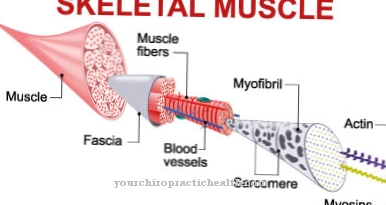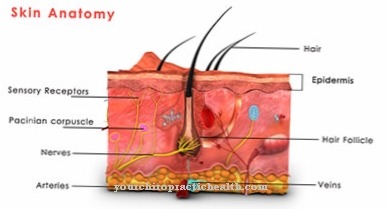Anhidrosis indicates a decreased productivity of the sweat glands. This can be caused by illness, medication or skin injuries. People with anhidrosis are prone to dangerous overheating. The opposite of anhidrosis is hyperhidrosis.
What is anhidrosis?

© Lavreteva - stock.adobe.com
People with anhidrosis are unable to sweat normally. However, perspiration is necessary for the body to cool itself.
Otherwise overheating can occur, which in the worst cases can even lead to a heart attack. However, anhidrosis is difficult to diagnose. Mild anhidrosis usually goes undetected and can be caused by many causes; for example through skin injuries, certain diseases or medication.
It is possible to be born with anhidrosis, but the disorder can also develop later. Treatment for anhidrosis is to cure the causative factors, if they can be found.
causes
Anhidrosis occurs when the sweat glands stop working, and this can have a variety of causes.
Nerve damage: The body's nervous system is complex and does a lot of important jobs. If the nerves no longer register overheating, for example, they may have suffered damage from (among others): diabetes, alcohol abuse, Parkinson's disease, multiple system atrophy, amyloidosis, Sjögren's syndrome, lung cancer and Horner's syndrome.
Skin diseases: Certain skin conditions that cause pore clogging are the most common cause of anhidrosis. But extensive injuries (from traffic accidents or burns) can also result in anhidrosis.
Drug: A large number of drugs can cause anhidrosis. These include, for example, heart and blood drugs, but also psychotropic drugs.
Genetic disorders: Some congenital diseases cause the sweat glands to function poorly.
Dehydration: If the body has not absorbed enough fluids to carry out its normal functions, it, combined with anhidrosis, can be fatal.
Symptoms, ailments & signs
Anhidrosis manifests itself through a number of symptoms. Overheating can lead to circulatory problems and as a result heat stroke and life-threatening circulatory collapse. In severe cases, multiple organ failure occurs as a result of overheating, from which the patient eventually dies. Local anhidrosis is less severe.
The disease is typically limited to certain areas of the body and causes, for example, coagulation disorders, inflammation or nerve damage. The dried out skin is also more prone to rashes, infections and other skin changes. In the long term, anhidrosis can lead to premature aging of the skin. In the area of the muscles, overheating can lead to paralysis, cramps and sensory disorders.
Jerks cannot be ruled out either. Acute anhidrosis manifests itself as dizziness, nausea and itching. Most of the time, there is also reddening of the skin or even swelling that is sensitive to pressure. Overall, the patient is more sensitive to high and low temperatures.
This leads to increased discomfort and sudden states of exhaustion. Outwardly, anhidrosis is sometimes reddened by the skin. In addition, the skin in the affected area is very warm and painful to the touch. Since a sweat gland disorder can manifest itself through a variety of symptoms, a medical examination is always necessary.
Diagnosis & course
A doctor can diagnose anhidrosis by doing a physical exam and asking about the symptoms and medical history. But further tests may be necessary to be sure.
Axon Reflex Test: During this test, small electrodes are placed on arms or legs. By stimulating the sweat glands, they are stimulated to produce. At the same time, the amount of leaking liquid is measured.
Silastic sweat imprint: Similar to the previous test. But the amount of liquid is measured through the imprint in a special rubber layer (Silastic).
Thermoregulatory sweat test: In this test, the patient is wetted with a special powder that has a colored reaction when it comes into contact with liquid. Then the patient comes into a warmed room where his perspiration is recorded by photos.
Biopsy: Tissue extraction is also possible. Affected sweat glands can be analyzed directly here.
Complications
Anhidrosis can cause a variety of complications. First of all, there is a risk that the body will overheat due to the lack of perspiration. This can lead to circulatory problems and as a result heat stroke and potentially life-threatening circulatory collapse. In extreme cases, the overheating causes multiple organ failure and ultimately leads to the death of the patient.
Local anhidrosis is limited to certain areas of the body and can cause various problems such as clotting disorders, nerve damage and inflammation. The dried out skin also has a higher risk of rashes, infections and severe skin changes up to premature skin aging. Insufficient cooling of the muscles can lead to muscle cramps and symptoms of paralysis. Acute anhidrosis causes dizziness and nausea as well as itching and skin changes.
In addition, there is an increased sensitivity to high and low temperatures, which is often associated with severe malaise and states of exhaustion. As part of anhidrosis therapy, prescribed care products can lead to allergies and thus to an intensification of the symptoms. Other complications depend on the underlying disease and range from chronic nerve damage (in nerve diseases) to spinal cord damage (in syringomyelia).
When should you go to the doctor?
If no or very little perspiration is observed in the child, the pediatrician should be spoken to. The medical professional can diagnose anhidrosis through questioning and physical examination and suggest appropriate treatment.
Sometimes simple precautions are enough to provide adequate relief from problems caused by anhidrosis. However, in severe cases, the condition must be closely monitored by a doctor. See a doctor regularly, especially with children and adolescents suffering from anhidrosis.
While serious complications are unlikely, medical education about avoidance strategies and the dangers of the disease is always advisable. If cramps, hot flashes and similar symptoms do not go away after a few minutes, medical help is required.
An emergency doctor must be called in the event of severe symptoms such as overheating or severe circulatory problems. In addition to this, first aid measures such as cooling and removing cramped clothing are sometimes also to be carried out. Those affected should then speak to the doctor and consider further therapeutic measures.
Doctors & therapists in your area
Treatment & Therapy
Treatment for anhidrosis is not always necessary. If this affects only small areas of the body, it will hardly have any serious effects on the organism.
But anhidrosis, which leads to a greatly reduced perspiration, can be life-threatening. There are several therapies available, depending on the disorder causing the anhidrosis. Symptoms caused by heat, in particular, require prompt treatment. In the event of acute overheating, the person affected should lie down and cool off. Cold fruit juice or sports drinks with an increased electrolyte content help the body to regenerate.
If cramps and symptoms do not resolve after an hour, medical help should be sought. As a precaution, it is advisable to rest for a few hours before resuming strenuous activity. In some cases, overheating can lead to a heart attack. If this occurs, the person concerned needs an emergency doctor immediately.
Until this is not there, the person affected should be brought to a cool, shady place, his clothes loosened and, if necessary, sprinkled with cold water.
Outlook & forecast
Weak anhidrosis does not have any noticeable effects on the body or the patient's wellbeing. Treatment is not necessary, which means that the symptoms can be present for life without any effects or a feeling of illness.
With severe anhidrosis, it is difficult to determine the cause. Once this has been clarified, the forecast prospects are usually good. Many patients receive medical care with a subsequent permanent cure for the disease. Alternatively, knowledge about precautionary techniques is conveyed and the recognition of early warning notices is learned. Without an explanation of the cause, the symptoms can increase. The forecast outlook is then less optimistic.
In rare cases, a life-threatening condition threatens. If the sweat production decreases continuously and applied therapies remain ineffective, the body threatens to overheat. Multiple organ failure with fatal consequences is possible. However, if the early warning signals are recognized, any patient without an established cause of anhidrosis can take measures to alleviate the problem.
In addition, preventive measures should be taken on a daily basis, even if there are no complaints. With this care for yourself and your own health, the risk of life threatening is significantly reduced. Nevertheless, an outbreak of symptoms is to be expected at any time, as no cure can be achieved without treating the cause.
prevention
Anhidrosis itself cannot be prevented, but the life-threatening consequences of overheating can be avoided. People with anhidrosis should wear loose and light clothing when it is very warm. On hot days you should stay in cool rooms. You should also avoid overexertion and learn to listen to your body's warning signals.
Aftercare
After the anhidrosis has been treated, no further symptoms should arise. During the follow-up care, the doctor examines the patient again comprehensively so that any symptoms can be identified and treated immediately. The doctor will do a skin exam. If there are no abnormalities, this is usually sufficient to make the diagnosis.
If there are unusual skin changes, further examinations must be undertaken. In any case, the doctor will have a conversation with the patient. A low level of well-being or complaints indicate that the anhidrosis has spread. Depending on the patient's state of health, further measures must therefore often be initiated.
Anhidrosis follow-up care may also include examinations by other specialists. In addition to the dermatologist, specialists in internal medicine are often included in the follow-up care. Depending on the cause, nutritionists and physiotherapists may also need to be involved so that the trigger of anhidrosis can be treated effectively.
If these measures are ineffective, symptomatic therapy must be restarted. If the outcome is positive, follow-up care is limited to a few doctor's appointments, during which the course of the disease is checked and the prescribed medication is tapered off if necessary.
You can do that yourself
Anhidrosis does not necessarily require medical treatment. If the disease only affects small areas of the body, the reduced perspiration can be counteracted with a few self-help tips and home remedies.
First of all, direct sunlight and vigorous physical exertion should be avoided. Sweating can also be reduced by using cool compresses and regular, light yoga exercises. Dietary measures such as avoiding caffeine and spicy foods also help to adapt sweat production to the disease in a natural way.
Anhidrosis sufferers should definitely avoid stimulants such as alcohol and nicotine. However, should it overheat, lie down and cool off. Those affected should rest in a cool, shady place, loosen their clothes and, if necessary, pour some water over themselves.
Cold mineral water, fruit juice and sports drinks help the body to regenerate. If available, medicinal plants such as nerve-soothing red clover and anticonvulsant mugwort can also be used. Despite all measures, overheating can lead to severe circulatory problems. In the event of a collapse or a heart attack, the emergency doctor must be called immediately. First aid measures may need to be taken until the doctor arrives.



























